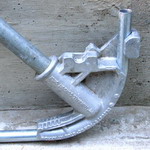» Need Electrical Help? Ask the Electrician
Electrical Tubing and Conduit Benders
Electricians Tools for Electrical Work

|
By Dave Rongey
Summary: Here are the Conduit Benders I use on most all of my electrical jobs and projects. © By: Dave Rongey |
EMT Conduit Benders and Rigid Pipe Benders
Example of Electrical Conduit Benders:
- EMT Conduit Benders: Used for bending thin wall electrical metallic tubing (EMT).
- Offset Conduit Benders: Used for creating an offset bend in thin wall electrical metallic tubing (EMT).
- Rigid Pipe Benders: Used for bending thick wall electrical rated rigid steel pipe.
Electrical Conduit and Pipe Benders
|
|
Full Radius EMT Conduit BenderThe bender itself is bought as a shoe and threaded onto a rigid metal pipe which may be interchangeable with a few different sizes of benders. The bender to the left is a full size radius bender. Some brands of benders for larger size conduits may be used for rigid conduits which are one size smaller than the EMT size conduit. |
|
Short Radius EMT Conduit BenderThis is a short radius bender used for 1/2 inch EMT. Keep in mind that when using short radius bends it will be more difficult to pull in the wire. |
|
Offset EMT Conduit BenderThis is a Offset Bender which is great for creating the offset bend allowing the EMT to line up perfectly with most metal junction box openings, such as the 4-Square box. This offset bender is available for 1/2 and 3/4 inch EMT. |
|
Hickey Rigid Pipe BenderThis hickey bender is used for bending heavy wall rigid pipe and is great for creating bends in tight places, like trenches etc. |
|
|
|||||||
| Electrical Wiring Tools Questions and Answers |
The Safest Way to Test Electrical Devices and Identify Electric Wires!The Non-Contact Electrical TesterThis is a testing tool that I have had in my personal electrical tool pouch for years, and is the first test tool I grab to help identify electrical wiring. It is a Non-contact tester that I use to easily Detect Voltage in Cables, Cords, Circuit Breakers, Lighting Fixtures, Switches, Outlets and Wires. Simply insert the end of the tester into an outlet, lamp socket, or hold the end of the tester against the wire you wish to test. Very handy and easy to use.
The Quickest Way to Check for Faulty Electrical Wiring!The Plug-In Outlet TesterThis is the first tool I grab to troubleshoot a problem with outlet circuit wiring. This popular tester is also used by most inspectors to test for power and check the polarity of circuit wiring. It detects probable improper wiring conditions in standard 110-125 VAC outlets Provides 6 probable wiring conditions that are quick and easy to read for ultimate efficiency Lights indicate if wiring is correct and indicator light chart is included Tests standard 3-wire outlets UL Listed Light indicates if wiring is incorrect Very handy and easy to use.
Strip Off Wire Insulation without Nicking and Damaging the Electric Wire!The Wire Stripper and Wire CutterMy absolute favorite wire stripping tool that I have had in my personal electrical tool pouch for years, and this is the tool I use to safely strip electrical wires. This handy tool has multiple uses: The wire gauges are shown on the side of the tool so you know which slot to use for stripping insulation. The end of the tool can be used to grip and bend wire which is handy for attaching wire onto the screw terminals of switches and outlets.. The wire stripper will work on both solid and stranded wire. This tool is Very Handy and Easy to Use. |
||
Residential Electrical Parts and AccessoriesLight Switches 120volt Outlets Circuit Breakers Electrician Tools Voltage Testers |















